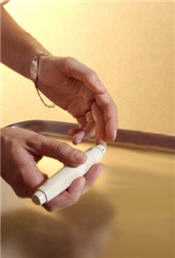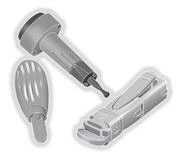CDC Clinical Reminder: Use of Fingerstick Devices on More than One Person Poses Risk for Transmitting Bloodborne Pathogens
Summary
The Centers for Disease Control and Prevention (CDC) has become increasingly concerned about the risks for transmitting hepatitis B virus (HBV) and other bloodborne pathogens to persons undergoing fingerstick procedures for blood sampling — for instance, persons with diabetes who require assistance monitoring their blood glucose levels. Reports of HBV infection outbreaks linked to diabetes care have been increasing [1, 2, 3]. This notice serves as a reminder that fingerstick devices should never be used for more than one person.
Background

Figure 1: Reusable fingerstick device*
Fingerstick devices are devices that are used to prick the skin and obtain drops of blood for testing. There are two main types of fingerstick devices: those that are designed for reuse on a single person and those that are disposable and for single-use.
- Reusable Devices: These devices often resemble a pen and have the means to remove and replace the lancet after each use, allowing the device to be used more than once (see Figure 1). Due to difficulties with cleaning and disinfection after use and their link to numerous outbreaks, CDC recommends that these devices never be used for more than one person. If these devices are used, it should only be by individual persons using these devices for self-monitoring of blood glucose.
- Single-use, auto-disabling fingerstick devices: These are devices that are disposable and prevent reuse through an auto-disabling feature (see Figure 2). In settings where assisted monitoring of blood glucose is performed, single-use, auto-disabling fingerstick devices should be used.
The shared use of fingerstick devices is one of the common root causes of exposure and infection in settings such as long-term care (LTC) facilities, where multiple persons require assistance with blood glucose monitoring. Risk for transmission of bloodborne pathogens is not limited to LTC settings but can exist anywhere multiple persons are undergoing fingerstick procedures for blood sampling. For example, at a health fair in New Mexico earlier this year, dozens of attendees were potentially exposed to bloodborne pathogens when fingerstick devices were reused to conduct diabetes screening.
Recommendations

Figure 2: Single-use, disposable fingerstick devices*
Anyone performing fingerstick procedures should review the following recommendations to ensure that they are not placing persons in their care at risk for infection.
- Fingerstick devices should never be used for more than one person.
- Auto-disabling single-use fingerstick devices should be used for assisted monitoring of blood glucose.
These recommendations apply not only to licensed healthcare facilities but also to any setting where fingerstick procedures are performed, including assisted living or residential care facilities, skilled nursing facilities, clinics, health fairs, shelters, detention facilities, senior centers, schools, and camps. Protection from infections, including bloodborne pathogens, is a basic requirement and expectation anywhere healthcare is provided.
Additional information is available at:
- Infection Prevention during Blood Glucose Monitoring and Insulin Administration
- Diabetes and Viral Hepatitis: Important Information on Glucose Monitoring
- FDA Communication: Use of Fingerstick Devices on More than One Person Poses Risk for Transmitting Bloodborne Pathogens
References
- Centers for Disease Control and Prevention. Transmission of hepatitis B virus among persons undergoing blood glucose monitoring in long-term-care facilities – Mississippi, North Carolina, and Los Angeles County, California, 2003-2004. MMWR 2005;54:220-223.
- Patel AS, White-Comstock MB, Woolard D, Perz JF. Infection Control Practices in Assisted Living Facilities: A Response to Hepatitis B Virus Infection Outbreaks. ICHE 2009;30(3):209-214.
- Thompson ND, Perz JF. Eliminating the Blood: Ongoing Outbreaks of Hepatitis B Virus Infection and the Need for Innovative Glucose Monitoring Technologies. J Diabetes Sci Technol 2009;3(2):283-288.
* Disclaimer: Images provided on this page are examples only and do not represent an endorsement by the Centers for Disease Control and Prevention.
- Page last reviewed: August 23, 2010
- Page last updated: February 9, 2011
- Content source:


 ShareCompartir
ShareCompartir